“If conditions do evolve in the manner that most of my [Fed] colleagues and I anticipate, I would expect the level of the federal funds rate to be normalized only gradually, reflecting the gradual diminution of headwinds from the financial crisis and the balance of risks I have enumerated of moving either too slowly or too quickly.”
(Janet Yellen, Federal Reserve Chairwoman)
The Punchbowl is still out…
As the first quarter of 2015 draws to a close, the world’s central banks continue to keep the bar open. While many FOMC members have indicated that the olives are running low and there are no more swizzle sticks, they are at the same time winking that the kegs are still cold and tapped. Meanwhile in Europe, champagne corks are being fired as fast as humanly possible while savers are being charged and borrowers are being paid.
For equity markets, this means that violent, multi-day pullbacks will continue to be met with investors sensing an opportunity and have the cheap capital to take a stab at it. And it is not just equity traders who have access to cheap financing, but also corporations and buyout firms. While investors ran scared last week and companies withdrew their buybacks as earnings season neared, the buyout firms and corporations stepped up to fill the void. 3G/Berkshire Hathaway (NYSE:BRKa) bought Kraft Foods (NASDAQ:KRFT), Intel (NASDAQ:INTC) entered talks with Altera (NASDAQ:ALTR) and UnitedHealthcare grabbed Catamaran (NASDAQ:CTRX). These are only the massive, 11 figure deals. Plenty of smaller $100m to $10b deals also occurred last week.
So stop worrying about Yemen, Iran, Greece and just place a good drink order to observe all of this market volatility instead.
Where was the investor fear last week? Try in the Biotech and Semiconductor sectors…
Biotechs and Semis have been top performers for years and last week someone decided to take a few stacks of high society off of each, which caused some others to worry.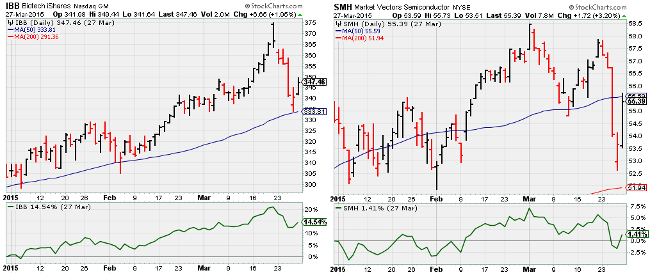
But while I saw heavy volume being lifted in the 2 big biotech ETFs (NASDAQ:IBB) & (NYSE:XBI), I saw little evidence of selling across the largest biotech stocks…
This leads me to believe that the ETF selling was done by more aggressive owners and not the long term holders. We can only wait to see if the aggressive early selling of the ETFs was the smart or dumb selling.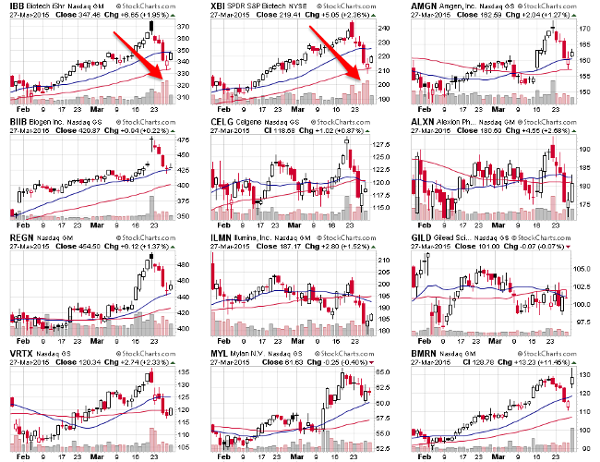
Has anyone noticed that 2015 earnings estimates are moving higher again?
With all the focus on the first quarter earnings pressures due to Energy earnings reductions, the euro and questionable weather, you might have missed that total bottoms up earnings estimates are again rising.
Breaking down 2015 growth by Sector shows that only Energy has seen a decline…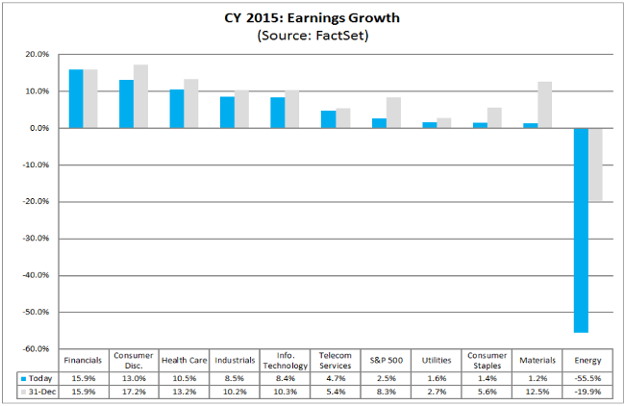
Globally, analysts are taking an axe to Energy earnings while not sharing any gains with those that consume energy…
@NickatFP: Analysts have adopted a “glass half-empty” approach to oil impact on earnings estimates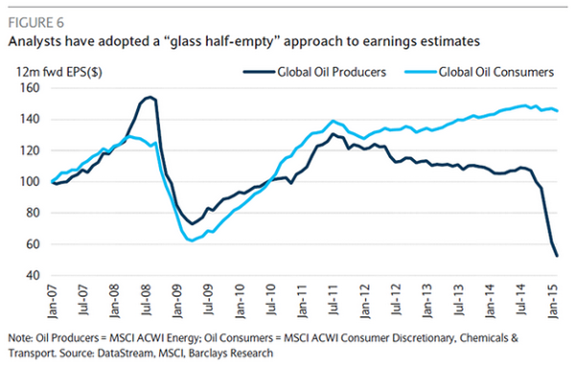
It’s 2015 and Wall Street now loves Volatility as their CFO’s are looking for larger Q1 piggy banks…
Wall Street banks are set to enjoy their best quarter from trading in three years after a resurgence in volatility caused by diverging monetary policies around the world.
Combined revenues from trading fixed income and equities at JPMorgan Chase (NYSE:JPM), Bank of America (NYSE:BAC), Citigroup (NYSE:C), Goldman Sachs (NYSE:GS), and Morgan Stanley (NYSE:MS) could rise as high as $25bn in the first quarter, according to Barclays (LONDON:BARC), compared with $21.6bn in the first quarter of 2014. At Morgan Stanley, analysts expect net income — boosted by improved trading revenues — to hit $1.55bn, its best result in more than seven years, or 31 quarters. At Goldman, first quarter fixed income trading revenues are expected to enjoy their first year-on-year rise since 2009
And not just Trading Revenues but Corporate Debt issuance is running off the chart…
A decline in long-term U.S. interest rates since the robust jobs figures at the start of the month has propelled a surge in corporate borrowing. The U.S. investment grade market has priced $21.4bn in deals so far this week, and according to Royal Bank of Scotland (LONDON:RBS), that ”brings March’s month-to-date volume to $140bn, $8bn shy of the all-time monthly record set in September 2013 at $148bn.” Investor demand for corporate debt remains solid, helped in part by expectations the Federal Reserve won’t tighten policy until at least June, while recent economic data has been lackluster to say the least, reports Michael MacKenzie, markets editor. The 10-year Treasury yield has dropped from a peak of 2.25 per cent earlier this month to just under 2 percent
I have missed the strength in European small caps. Another very good sign for Europe’s risk markets…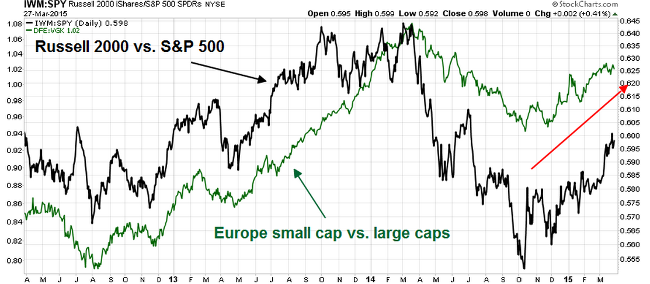
Back to the U.S., while the Biotechs had a pullback, it is tough to find signs of weakness among the other meters of froth…
A similar picture can be found in the relative performance of the high-beta, high octane and glamour groups of the stock market, such as biotech, internet, broker-dealers, IPOs and social-media stocks. Does this look like a picture of an impending correction?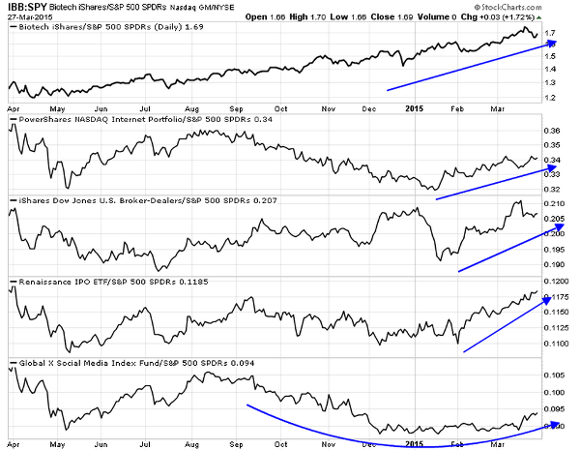
For the week, all XL sectors declined. Staples did best (thanks Kraft) while Financials continued in their wing-nut ways…
More broadly, the International markets outperformed the U.S. as the dollar declined, but it was a difficult week for all asset classes…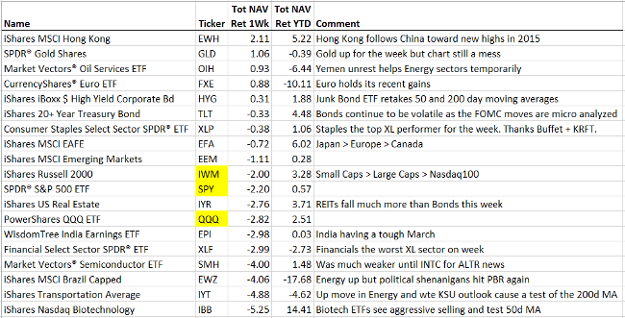
Looking more closely at the International Indexes shows better gains than the U.S. in both Dollar and local FX terms…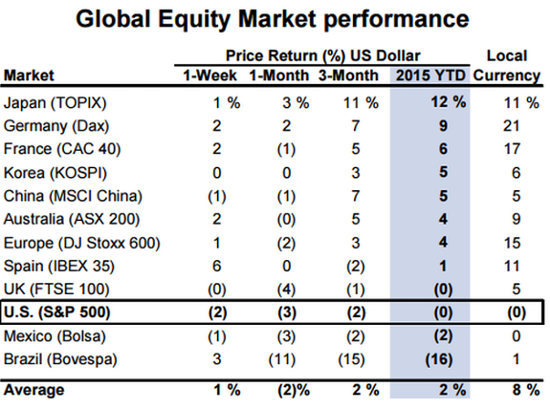
And the economic surprises in Europe continue to impress…
@RichardBarley1: Ex-France and Germany, EZ new order growth fastest since July 07, job creation strongest since Sep 07, says Markit.
As interest rates go negative, European borrowing is going vertical…
The Eurozone is benefitting from near-zero interest rates, QE, a weak euro, rising bank lending, soaring stock prices, and lower oil prices. If these six cylinders don’t revive the region’s economy, then nothing will. Of course, the possibility of a Grexit continues to hang over the Eurozone. However, the strong performance of stocks suggests that investors believe it won’t happen or it won’t matter much if it does. I tend to agree.
And of course being paid to borrow is causing the Consumer to bounce…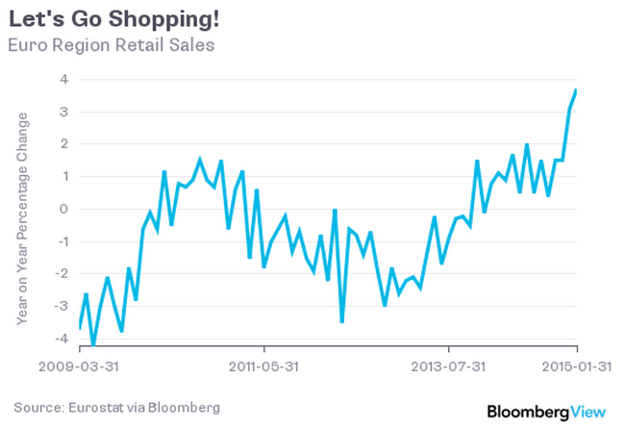
Although the textbooks suggest deflation — defined as a sustained period of falling prices — makes consumers unwilling to spend because they expect to get better bargains in the future, that doesn’t seem to be happening in the euro region. In January, shoppers propelled retail sales up by 1.1 percent in the month, beating the 0.2 percent increase forecast by economists. The annual figure of 3.7 percent was the fastest growth in almost a decade, and outstripped economists’ expectations for a 2.3 percent gain
But not all of Europe is benefiting from negative interest rates…
The chances of Greece leaving the euro area are now 50-50 and the country could go “down the drain,” billionaire investor George Soros said. “It’s now a lose-lose game and the best that can happen is actually muddling through,” Soros, 84, said in a Bloomberg Television interview due to air Tuesday. “Greece is a long-festering problem that was mishandled from the beginning by all parties.”… “You can keep on pushing it back indefinitely,” making interest payments without writing down debt, Soros said. “But in the meantime there will be no primary surplus because Greece is going down the drain.
Greece should probably be moved to the Emerging Market book which is oh, so cheap…
Emerging markets’ discount has increased. Using the multiples to book value at which the MSCI indices trade as a measure, they now trade at only 65 per cent of the multiple of developed world stocks. This 35 per cent discount is the deepest in 12 years. As recently as November 2011, they sold at a premium. This sounds encouraging. Further, the Federal Reserve has issued a reprieve. Its March meeting left the timing of a first U.S. rate rise dependent on the data (which has looked weaker of late), and caused many to push back their forecasts for rising rates. That checked the rise of the U.S. dollar, which had become extreme and gave relief for emerging markets. Their stocks have outperformed since the Fed spoke.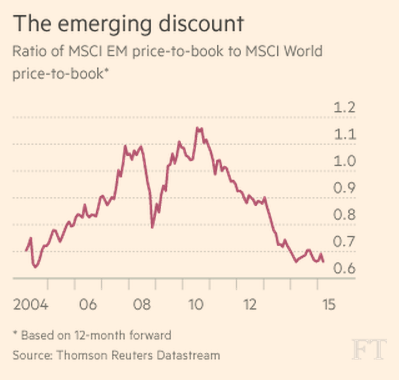
Howard Marks has the most read piece of the week. In it, he reminded us that just because a security is listed as marketable doesn’t mean that it is liquid. Go back and review your AAA rated bond prices in 1998 when Long Term Capital Management imploded or 2007/2008 when the mortgage bubble burst the world unwound…
“It’s often a mistake to say a particular asset is either liquid or illiquid. Usually an asset isn’t “liquid” or “illiquid” by its nature. Liquidity is ephemeral: it can come and go. An asset’s liquidity can increase or decrease with what’s going on in the market. One day it can be easy to sell, and the next day hard. Or one day it can be easy to sell but hard to buy, and the next day easy to buy but hard to sell. In other words, the liquidity of an asset often depends on which way you want to go and which way everyone else wants to go.
Now after digesting Howard’s piece, go and dig into Josh Brown’s work in Fortune. Then worry about any leverage that might exist in your bond funds…
Leverage: According to Bloomberg, the $2.45 billion [Un-Named] Unconstrained Bond Fund is currently holding 198.4% of its assets in corporate bonds. The $1.17 billion [Un-Named] Total Return Unconstrained Bond Fund is reported to be invested in a mix of 378% corporate bonds, 236% mortgage bonds, and 232% government bonds. The $28 billion [Un-Named] Strategic Income Opportunities Fund, the largest of the group, is currently 202% long the mortgage bond market. By adding leverage, a low duration portfolio is de facto magnified to a very large degree
No surprise here, but Large Hedge Funds continue to get all the assets. You must get to 1 stick if you want to get on the radar screen…
Last year, nearly 90% of the $76.4 billion of net inflows for hedge funds went to firms managing at least $1 billion, according to HFR, a Chicago firm that tracks hedge funds. About half of that money went to firms with at least $5 billion under management. Meanwhile, smaller firms, defined as those managing less than $100 million, took in $6 billion, or about 8% of total flows, similar to what happened in 2013 and previous years
Facebook (NASDAQ:FB) paid $22 billion last year to kill one of Wireless companies’ fastest growing sources of revenues…
The time users are spending on messaging services has encouraged investors to value them highly, even though it is not yet clear how some of them will make money—much as happened with the rise of Twitter (NYSE:TWTR) and with Facebook's (NASDAQ:FB) original service, its social network. WhatsApp handled more than seven trillion messages last year, about 1,000 per person on the planet. In Britain users spent as much time on WhatsApp as on Facebook’s social-networking app, according to Forrester, another research firm. In China subscribers to WeChat are estimated to use the app for about 1,100 minutes a month on average.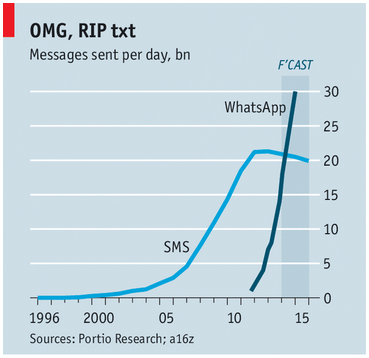
What did 3G and Berkshire Hathaway see in Kraft that you didn’t?
Since 3G has run Heinz, its gross operating margins have risen by eight percentage points. Mr. Buffett and 3G are paying top dollar for Kraft. Based on last year’s underlying profit figure, the deal will generate a miserly 4% post-tax return on capital. Were Kraft to enjoy the same margin uplift that Heinz has, this would rise to 6%–still subpar. So, to make the numbers work, Kraft will also have to expand its sales, preferably outside America. The plan is to use Heinz’s international footprint (it generates over half its sales abroad) to help Kraft’s all-American brands go global.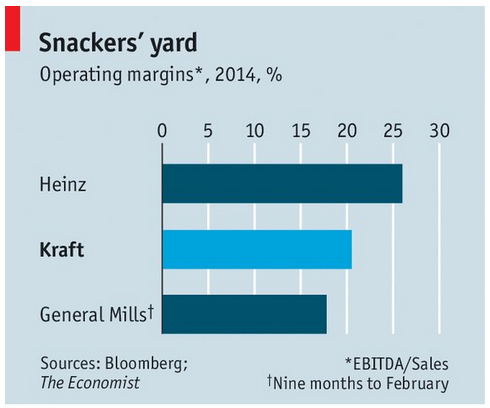
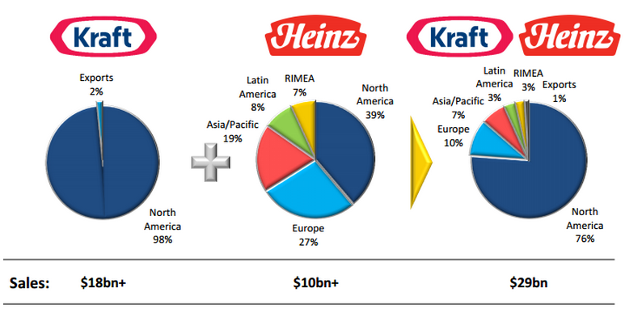
Meanwhile, an East Coast CFO trades snow and fall foliage for California drought and xeriscape…
And Finally, Stanford University takes it’s tuition-free line +25% to $125,000 in family income. Expect other well-endowed schools to follow as the recruiting race is on for top High Schoolers with total college enrollments falling due to the pickup in the U.S. economy.
Under the new policy, Stanford will expect no parental contribution toward tuition from parents with annual incomes below $125,000 – previously $100,000 – and typical assets. And there will be zero parental contribution toward tuition, room or board for parents with annual incomes below $65,000 – previously $60,000 – and typical assets. “Our highest priority is that Stanford remain affordable and accessible to the most talented students, regardless of their financial circumstances,” said Provost John Etchemendy. “Our generous financial aid program accomplishes that, and these enhancements will help even more families, including those in the middle class, afford Stanford without going into debt. Over half of our undergraduates receive financial aid from Stanford, and we are pleased that this program will make it even easier for students to thrive here.
Congrats to everyone in the Class of 2015 who accepted the School of their choice…
If you like the ideas Blaine Rollins shares each week in the 361 Capital Research Briefing…
Then you should learn more about how he incorporates these ideas in the new mutual fund he is managing, the 361 Global Macro Opportunity Fund. Contact 361 Capital or your advisor for additional information.
In the event that you missed a past Research Briefing, here is the archive
The information presented here is for informational purposes only, and this document is not to be construed as an offer to sell, or the solicitation of an offer to buy, securities. Some investments are not suitable for all investors, and there can be no assurance that any investment strategy will be successful. The hyperlinks included in this message provide direct access to other Internet resources, including Web sites. While we believe this information to be from reliable sources, 361 Capital is not responsible for the accuracy or content of information contained in these sites. Although we make every effort to ensure these links are accurate, up to date and relevant, we cannot take responsibility for pages maintained by external providers. The views expressed by these external providers on their own Web pages or on external sites they link to are not necessarily those of 361 Capital.
